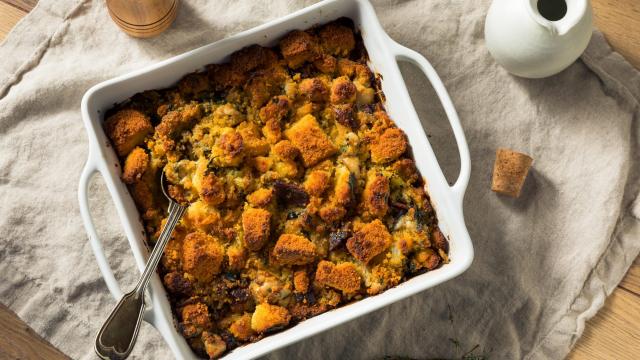Being from Mississippi but growing up in Los Angeles made for a confusing childhood, especially in the culinary sense. Not only was the food different in every way — nary a crock of bacon grease was to be found — things were named differently. “Coke” became “soda,” my mum couldn’t find boiled peanuts anywhere, and dressing was replaced with stuffing — a dish I had never heard of before our move out west.
The taxonomy of stuffing versus cornbread should be cut and dry. It’s stuffing if you stuff it inside the bird and dressing if you cook it in a separate pan. But there are a few states in the deep South that refuse to even acknowledge “stuffing” as a word or a concept, much less a dish, and — according to this 2013 article from Epicurious — Mississippi is the most stubborn of all. (I have also heard that the fine non-Southern people of Iowa call it “dressing,” which delights me.)
Both are bread dishes, though most southern dressing is made with cornbread. (“Cornbread stuffing” is not a thing.) Both stuffing and dressing are moistened with stock and held together with eggs, and both usually contain onion and celery, as well as sage and all the other usual herbs. Both take quite well to tweaks and riffing, which I enjoy. I don’t know if those above the Mason-Dixon line add sausage, but it’s quite common amongst my people. I enjoy nearly every iteration of the dish, no matter what it’s called, but I prefer it cooked outside of the bird.
Why dressing is better than stuffing on Holidays
Regional loyalty aside, using the term “stuffing” doesn’t make much sense anymore, because stuffing bread inside a bird doesn’t make any sense. Cooking the bread-based side inside the cavity of your turkey is bad for both dishes. The stuffing gets saturated with bird juice, which is full of raw bird bacteria, meaning you now have to worry about the meat and meat juice-soaked bread reaching a safe temperature. (According to the USDA, this is 73ºC). Stuffing is hard to temp check when it’s inside a dead animal that’s sitting inside a hot oven, and the inside of that animal is damp, meaning you don’t get any browning, any crispy bits, or any texture beyond “damp bread.”
It doesn’t help the turkey either. Getting the stuffing to 73ºC (or the cavalier but, according to the Food Lab, technically safe 65ºC) will result in overcooked, dry breast meat. It will also block air flow in and out of the bird, which can result in uneven cooking, or at least make things take far longer than they should. And, if you’re spatchcocking your turkey — which is what you should be doing if you value taste over aesthetics — stuffing is physically impossible.
Will I be yelled at if I use the wrong word?
Truthfully, it doesn’t matter what you call it, as nearly everyone in the United States will know what you mean whether you say “stuffing” or “dressing.” I use both terms interchangeably, both professionally (for SEO reasons), and personally, because my Connecticut-born boyfriend’s brain thinks “salad” whenever I say “dressing.” (Plus, an argument could be made for calling it “stuffing,” based on the fact that I stuff it in my mouth.)
Far be it from me — a person from a state that calls all carbonated soft drinks “coke” — to argue semantics, but most of what is made and served in homes around the US is dressing, or at least it should be. Mississippi is not known for being “correct” about a lot of things (like the Civil War or COVID restrictions), but their refusal to call it anything but dressing is technically correct, the best kind of correct one can be. So let us have this one. Football season is so very hard.

Leave a Reply
You must be logged in to post a comment.